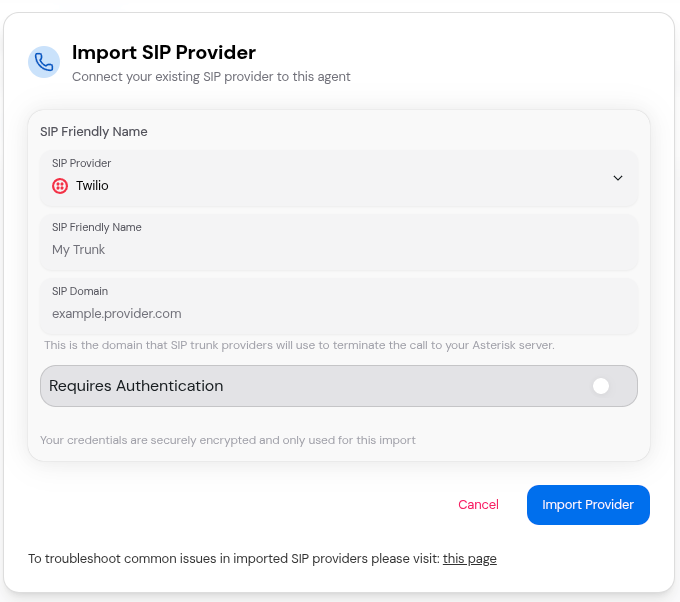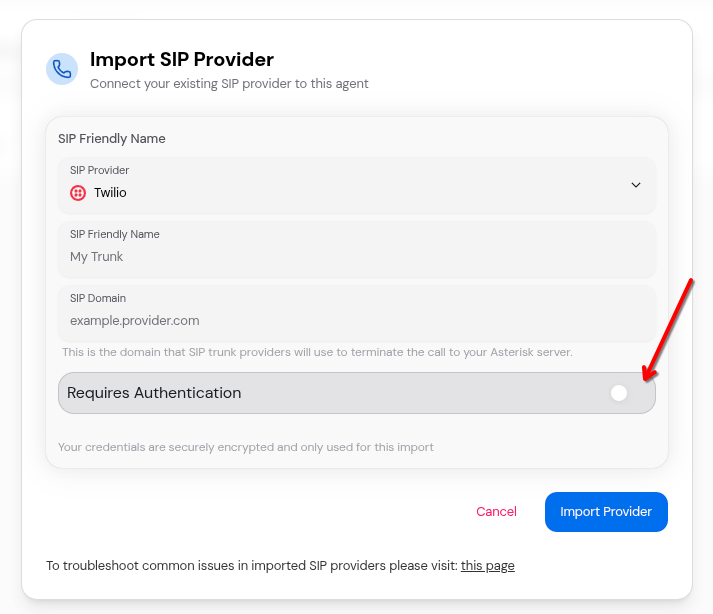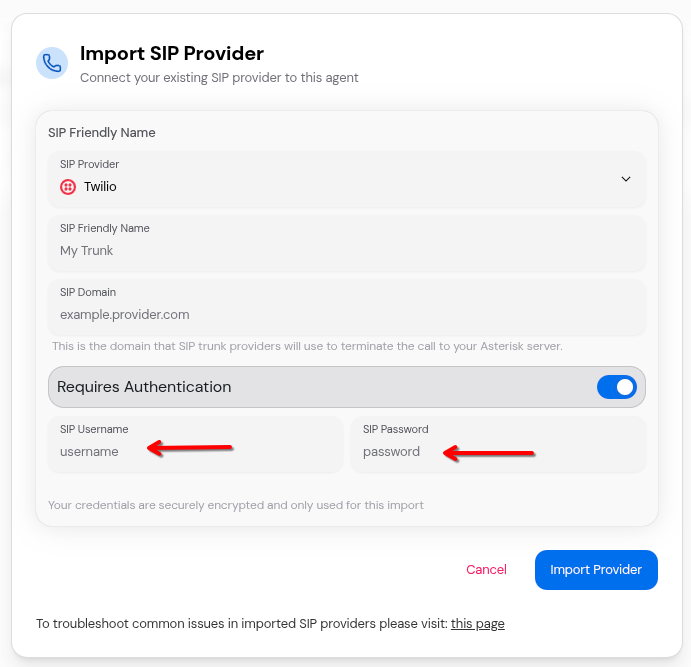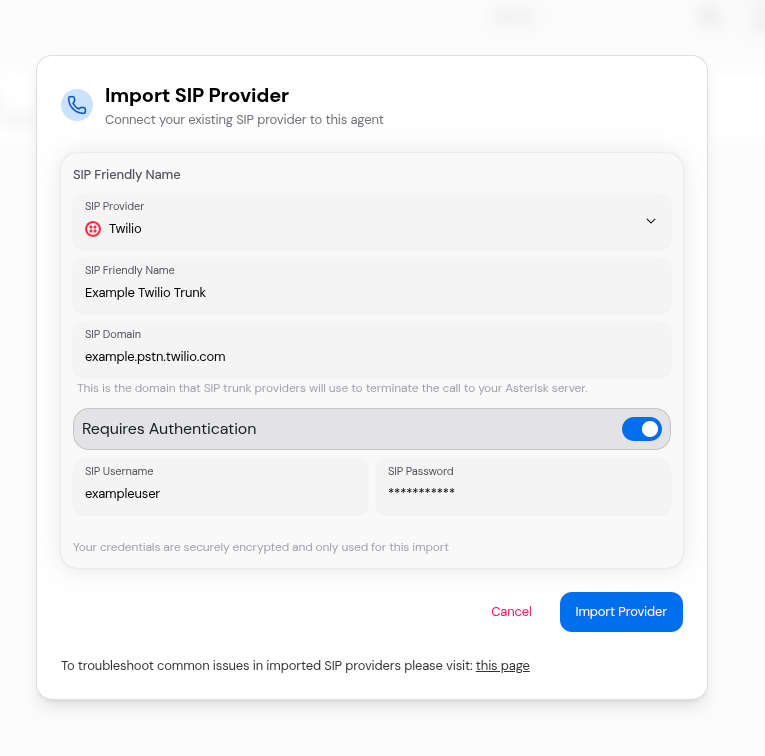Adding and Managing SIP Providers
A SIP provider (also called a SIP trunk) is your connection to the telephone network. This guide covers everything you need to know about adding and managing SIP providers in Convocore.Understanding SIP Providers
A SIP provider is the service that supplies you with phone numbers and connects your calls to the public telephone network. Think of it as your “phone company” for internet-based calling.What is a SIP Trunk?
A SIP trunk is a virtual phone line that uses your internet connection instead of traditional copper wires. It allows you to:- Make and receive phone calls over the internet
- Use multiple phone numbers on the same connection
- Scale up or down without physical infrastructure changes
- Reduce costs compared to traditional phone lines
Before You Begin
1
Choose a SIP Provider
Select a SIP trunk provider that fits your needs. Popular options include:
- Twilio: Best for developers, extensive API
- Peoplefone: European telecommunication provider. Since its founding in Switzerland
2
Gather Provider Information
Collect the following from your SIP provider:
- SIP domain/hostname (e.g.,
sip.provider.com) - Port number (usually 5060 for UDP or 5061 for TLS)
- Authentication credentials (username and password) (Optional)
- Any IP restrictions or firewall requirements
3
Configure Provider for Outbound Routing
Set up your SIP provider to route calls to the Convocore SIP server:
- IP Address:
161.35.79.143 - Port:
5060
Adding a New SIP Provider
Step 1: Open the Import Dialog
Navigate to the SIP section in your Convocore dashboard and click the ”+ New SIP Provider” button.
Step 2: Enter Provider Details
The import dialog will appear with the following fields:
Required Fields
Friendly NameA descriptive name for this SIP trunk. This is for management purposes only and won’t affect the connection
but it has to be unique.Examples:
- “Main Customer Support Line”
- “Sales Team Hotline”
- “Twilio Production Trunk”
- “Office PBX”
SIP DomainThe domain or hostname of your SIP provider. This is where the Asterisk server will send and receive SIP signaling.Examples:
sip.twilio.comsip.provider.com192.168.1.100(for local PBX)my-company.sip.vonage.com
Do NOT include
sip: prefix or port numbers. Just the hostname or IP address.Authentication Settings
Requires AuthenticationToggle this ON if your SIP provider requires username and password authentication. Most commercial providers require this for security.When enabled, two additional fields appear:
SIP UsernameThe username provided by your SIP provider for authentication. Sometimes called:
- Auth username
- SIP user
- Trunk username
- Account ID
SIP PasswordThe password provided by your SIP provider. Also known as:
- Auth password
- SIP password
- Trunk password
- Auth token
Your password is encrypted and securely stored. It’s never displayed in plain text after saving.


Step 3: Review and Import
Before clicking “Import Provider”, review your settings:
Step 4: Verify Creation
After successful creation, you’ll see:- A success notification confirming the provider was added
- Your new SIP provider appears in the list
- The provider shows 0 phone numbers initially

Configuration Examples
Example 1: Twilio SIP Trunk
Managing Existing Providers
Viewing Provider Details
Each SIP provider in your list displays:- Friendly Name: The name you assigned to the provider
- SIP Domain: The provider’s hostname
- Phone Number Count: How many numbers are configured
- Action Buttons: Delete and Add Number options

Expanding to View Phone Numbers
Click the chevron icon or anywhere on the provider card to expand and see all associated phone numbers.
Deleting a SIP Provider
Deleting a SIP provider is permanent and cannot be undone. All associated phone numbers will also be deleted.
1
Click Delete Button
Click the Delete button (trash icon) on the provider card
2
Confirm Deletion
A confirmation dialog will appear. Review the warning carefully
3
Confirm Action
Click Confirm to permanently delete the provider and all its phone numbers


Editing a SIP Provider
Currently, SIP provider editing is limited. To change provider settings, you’ll need to delete and recreate the provider. Your phone number configurations will need to be re-added.
- Updating friendly name
- Changing authentication credentials
- Modifying SIP domain
- Updating metadata
SIP Server Information
All SIP trunks are automatically routed through Convocore’s managed SIP server. You don’t need to configure or manage any server infrastructure. Server Details:- IP Address: 161.35.79.143
- Port: 5060
- Protocol: UDP/SIP
- Management: Fully managed by Convocore
Provider Limits
Your Convocore plan determines how many SIP providers you can configure:Maximum number of SIP providers allowed in your workspace
- Free Plan: 1 provider
- Pro Plan: 5 providers
- Enterprise Plan: Unlimited
sip-provider-limit-reached.png
Description: Screenshot showing the ”+ New SIP Provider” button disabled with a tooltip or message indicating the limit has been reached
When you reach your limit, the “New SIP Provider” button will be disabled. You’ll see a message:
- Delete an unused provider
- Upgrade your plan
Troubleshooting Provider Setup
Common Issues
Provider Creation Fails
Provider Creation Fails
Possible Causes:
- SIP domain is unreachable from the Asterisk server
- Incorrect authentication credentials
- Provider limit reached
- Network connectivity issues
- Verify the SIP domain is correct and accessible
- Double-check username and password
- Check your plan limits
- Contact support if issue persists
Cannot Delete Provider
Cannot Delete Provider
Possible Causes:
- Network error
- Provider has active calls
- Permission issues
- Wait for active calls to complete
- Refresh the page and try again
- Check browser console for errors
- Contact support with error details
Authentication Errors
Authentication Errors
Possible Causes:
- Wrong username or password
- Credentials expired or changed
- IP whitelisting required
- Authentication method mismatch
- Verify credentials with your SIP provider
- Check if IP whitelisting is required
- Ensure the Asterisk server IP is whitelisted
- Review your provider’s authentication requirements
Best Practices
Use Descriptive Names
Name your providers clearly to identify their purpose (e.g., “Customer Support Line” instead of “Trunk 1”)
Document Your Setup
Keep a record of which provider handles which phone numbers and their purposes
Test Immediately
Always make a test call right after adding a provider to verify it’s working
Monitor Usage
Regularly check your provider’s dashboard for call statistics and any issues
Secure Credentials
Never share your SIP credentials publicly or in screenshots
Plan for Redundancy
Consider setting up multiple providers for critical phone numbers as backup
Security Considerations
Security Best Practices
- Never expose your SIP credentials in public repositories or documentation
- Use strong, unique passwords for each SIP provider
- Enable IP whitelisting if your provider supports it
- Regularly rotate credentials
- Monitor for unusual call patterns that might indicate unauthorized access
Credential Storage
Convocore securely stores your SIP credentials:- Passwords are encrypted at rest
- Credentials are only used for SIP authentication
- They are never logged or displayed in plain text
- Access is restricted to authorized services only
Next Steps
Once your SIP provider is configured, you’re ready to add phone numbers:Configure Phone Numbers
Learn how to add and manage phone numbers for your SIP trunk
